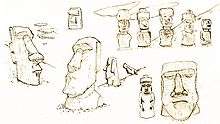Thumbnail
Thumbnails are reduced-size versions of pictures or videos, used to help in recognizing and organizing them, serving the same role for images as a normal text index does for words. In the age of digital images, visual search engines and image-organizing programs normally use thumbnails, as do most modern operating systems or desktop environments, such as Microsoft Windows, Mac OS X, KDE (Linux) and GNOME (Linux).
Implementation
Thumbnails are ideally implemented on web pages as separate, smaller copies of the original image, in part because one purpose of a thumbnail image on a web page is to reduce bandwidth and download time. Some web designers produce thumbnails with HTML or client-side scripting that makes the user's browser shrink the picture, rather than use a smaller copy of the image. This results in no saved bandwidth, and the visual quality of browser resizing is usually less than ideal.
Displaying a significant part of the picture instead of the full frame can allow the use of a smaller thumbnail while maintaining recognizability. For example, when thumbnailing a full-body portrait of a person, it may be better to show the face slightly reduced than an indistinct figure. However, this may mislead the viewer about what the image contains, so is more suited to artistic presentations than searching or catalogue browsing.
In 2002, the court in the US case Kelly v. Arriba Soft Corporation ruled that it was fair use for Internet search engines to use thumbnail images to help web users find what they seek.
Etymology
The word "thumbnail" is a reference to the human thumbnail and alludes towards the small size of the image or picture, comparable to the size of the human thumbnail.[1][2] While the earliest use of the word in this sense dates back to the 17th century,[3] the American Heritage Dictionary of Idioms is reported to have documented that the expression first appears in the mid-19th century to refer to 'a drawing the size of the thumbnail'.[4] The word was then used figuratively, in both noun and adjective form, to refer to anything small or concise, such as a biographical essay. The use of the word "thumbnail" in the specific context of computer images as 'a small graphical representation, as of a larger graphic, a page layout, etc.' appears to have been first used in the 1980s.[3]
Dimensions
- The Denver Public Library Digitization and Cataloguing Program produces thumbnails that are 160 pixels in the long dimension.[5]
- The California Digital Library Guidelines for Digital Images recommend 150-200 pixels for each dimension.[6]
- Picture Australia requires thumbnails to be 150 pixels in the long dimension.[7]
- The International Dunhuang Project Standards for Digitization and Image Management specifies a height of 96 pixels at 72 ppi.[8]
- DeviantArt automatically produces thumbnails that are maximum 150 pixels in the long dimension.
- Flickr automatically produces thumbnails that are a maximum 240 pixels in the long dimension, or smaller 75×75 pixels. It also applies unsharp mask to them.
- Picasa automatically produces thumbnails that are a maximum 144 pixels in the long dimension, or 160×160 pixels album thumbnails.
The term vignette is sometimes used to describe an image that is smaller than the original, larger than a thumbnail, but no more than 250 pixels in the long dimension.
Thumbnail sketches

Art directors, storyboard artists and graphic designers, as well as other kinds of visual artists, use the term "thumbnail sketch" to describe a small drawing on paper (usually part of a group) used to explore multiple ideas quickly. Thumbnail sketches are similar to doodles, but may include as much detail as a small sketch.
See also
| Wikimedia Commons has media related to Thumbnails (images). |
- Image organizer
- Contact print, a film cognate of the thumbnail
- Thumbshots
References
- ↑ "Online Etymology Dictionary". Online Etymology Dictionary. Retrieved 2010-03-05.
- ↑ "AllWords.com". Retrieved 2010-03-05.
- 1 2 "Random House Word of the Day". Retrieved 2010-03-05.
- ↑ "OPodictionary". Retrieved 2010-03-05.
- ↑ "About the Digitization and Cataloging Program at The Denver Public Library". Photoswest.org. Archived from the original on 2003-07-04. Retrieved 2013-03-13.
Thumbnail files are designed to display quickly and allow multiple images to be displayed simultaneously on a monitor screen for browsing. Thumbnails are 160 pixels on the long-dimension.
- ↑ "CDlib.org". California Digital Library. Retrieved 2013-03-13.
- ↑ "Local History Digitisation Manual". Libraries.vic.gov.au. Retrieved 2013-03-13.
- ↑ "The International Dunhuang Project - Standards for Digitisation and Image Management". IDP.bl.uk. Retrieved 2013-03-13.